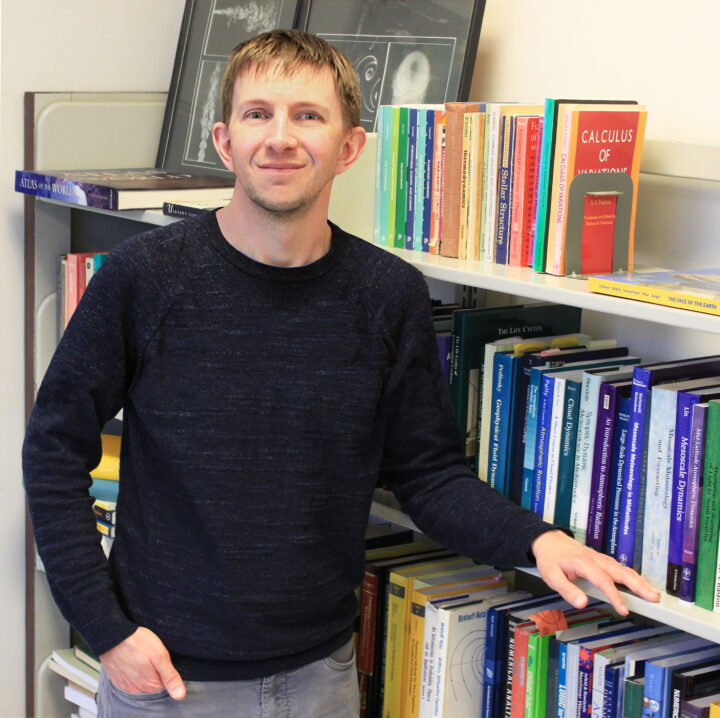
Physical Scientist
Division Leader, Weather and Climate Dynamics Division
Lead, NOAA Research Global-Nest Initiative
Contact Information
email Lucas.Harris@noaa.gov
Focus Areas:
- Global and global-nested kilometer-scale modeling
- Weather and climate extremes
- Numerical algorithms and dynamical cores
- Atmosphere digital twins
Lucas Harris
My research is focused on the development of the algorithms and software within the GFDL Finite-Volume Cubed-Sphere Dynamical Core, FV3, and its applications in the GFDL Modeling Suite and specifically the System for High-resolution prediction on Earth-to-Local Domains (SHiELD). Global and variable-resolution forecasts from SHiELD are available in real-time. I also contribute to applications in other FV3-based modeling systems including the Unified Forecast System. A recent article on the GFDL website describes our experimental model development work.
My personal expertise is on grid refinement techniques. The two methods for doing this in FV3 are grid nesting and grid stretching. These techniques allow FV3-powered models to be run at a very high resolution over a limited area convection-resolving forecasting, seasonal prediction, and regional climate modeling. Here is an introduction to variable-resolution techniques. Currently the FV3 Team is using grid nesting and grid stretching to develop global models suitable for storm-scale severe thunderstorm and hurricane forecasting, and for subseasonal prediction of severe weather, intense hurricanes, and the Madden-Julian Oscillation. An article and video about this work have been featured on the GFDL website.
I have also become more involved in the development of global storm resolving models (GSRMs). I led the development of the X-SHiELD GSRM contributed to DYAMOND. This development also supports our collaboration with Allen Institute for Artificial Intelligence (Ai2) Climate Modeling, which is creating the Ai2 Climate Emulator (ACE) trained on SHiELD output.
GFDL and NASA Goddard are leading the community effort behind Pace. This is a new performance-portable model incorporating FV3 numerics and ports of physical parameterizations written in the Python-based GT4py domain-specific language. The goal is performance-portability onto new computing architectures, especially GPUs. This is wholly open-developed and open to new contributors.
Recent presentations:
- I gave a virtual presentation on the Global-Nest Initiative to ESSIC at the University of Maryland in March 2025; the slides and a recording are available. I gave an earlier presentation on the Initiative in April 2023 for the UFS Webinar Series. You can watch it on YouTube here, or see the slides here.
- Similarly, I gave a talk, “FV3 in a Nutshell”, to the UFS S2S Application team in September 2023, to improve the broader understanding of FV3 and to address misconceptions.
- A lot of my tutorial presentations on FV3 are now available on the FV3 Documentation Page.
- In 2022 GFDL and Princeton CIMES hosted the 4th workshop on Physics-Dynamics Coupling in Weather & Climate Models, which I co-organized with the late Markus Sebastian Gross. The recorded presentations and slides are hosted by GFDL and publicly available.
- I have given a semi-technical introduction for non-specialists, entitled “FV3: The Present and Future of Weather and Climate Modeling”. The slides for this talk at NOAA’s Science Days (2017) are available and the recording of the public media briefing is also available (my segment starts at about 20:40).
- My colleagues Xi Chen, Linjiong Zhou, and Jan-Huey Chen, and I, gave a set of lectures on FV3 at the 2020 UFS Medium-Range Weather Application Users’ Training. The three lectures are, in order, on the FV3 algorithms and configuration, physics-dynamics coupling, and on applications. A recording of the session is available on YouTube.
- I gave a presentation on FV3’s design and its role in improving weather and climate models at ECMWF’s 2020 Annual Seminar. The slides and recording are both available. I do recommend checking out the other lectures as it is a great overview of the worldwide state of dynamical core development. Most highly recommended is my colleague Alistair Adcroft’s talk on Lagrangian remap methods, which is also applicable to FV3.
- Here is a longer technical presentation of the solver and another on grid refinement in FV3.
- In May 2017, GFDL was represented for the first time at the Hazardous Weather Testbed’s Spring Forecasting Experiment. Five-day forecasts from our global-to-3-km nested fvGFS (now called C-SHiELD) were submitted to HWT for community use. A presentation summarizing our own analysis of the results was given as an NGGPS virtual seminar. Since then GFDL has participated in the Spring Experiment every year, contributing both real-time C-SHiELD simulations and having our scientists participate in the Experimental Forecast Program.
Other projects and documents
I have written a simple but efficient and highly flexible feature tracker, called GFDL QuickTracks, primarily for tropical and extratropical cyclones. An unmaintained version of the code and scripts is available on GitHub.
I have a few nice GrADS scripts, along with examples, that I use for some of my work that others may find helpful.
Ray Pierrehumbert’s classic essay on mountain gravity-wave drag parameterization is difficult to find online. A copy is available at ECMWF. (Many other excellent ECMWF conference proceedings, including many classic contributions by GFDL scientists, are available as well.) A conference proceeding describing the use of the Pierrehumbert and Wyman scheme in the Miyakoda GFDL model, also hard to find, is available here.
My colleague Xi Chen and I have submitted a comment on an article about grid staggering.


